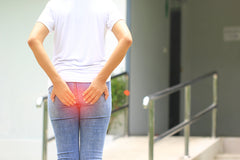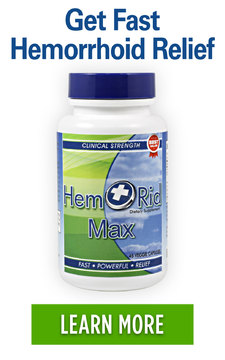How Do You Treat Piles? If You Have Piles, You Are in Need of a Treatment
Posted on 15 September 2018 by Maryanne Johnson
Share this post
So, how do you treat piles? Is there a cure that gets rid of piles forever? You are probably looking for a treatment that is effective, not too costly, and can shrink your piles—fast.
The bad news is that there is no real "cure" for piles, but the good news is that because this anorectal condition has been around for so long, many people have discovered tricks, treatments, and remedies that relieve symptoms of piles.
Piles are a common condition and are not fatal by any means, but if you don’t treat them, they can get worse. Untreated piles can lead to various complications, and by ignoring your piles, you may require certain operations or surgeries to remove them.
And while many remedies can be tried in your own home, privately, you will still want to talk to your GP about effective preventative measures.
If you are not eating right or getting aerobic exercise because of a sedentary lifestyle, your GP may instruct you to make some changes as these factors can significantly contribute to the development of piles.
The Sitz Bath
A sitz bath, for those unfamiliar with the term, is the submergence of your rectal area in typically lukewarm water. Sitz baths can be done in a regular tub, or a fitted bowl can be purchased at a local drugstore that is then placed over the toilet and filled with lukewarm water.
For some, a sitz bath provides comfort and relief of symptoms with the addition of essential oils or mineral salts.
There are hundreds of different plant and herb medleys that can be integrated with the warm water of a sitz bath, and unless you are allergic to specific oil or extract or have sensitive skin, this is an extremely low-risk way to treat piles.
Lavender, eucalyptus, and other botanical extracts can be added to a warm sitz bath for relaxation purposes and to soothe aching rectal muscles.
Epsom salt, commonly used by athletes to reduce muscle soreness from arduous and taxing workouts, can be mixed with the warm water for the same effect.
Researchers and studies conducted have debated the actual effectiveness of a sitz bath as a means to treat piles, and many results have gone back and forth as to whether the warm water can reduce swelling or help subside symptoms of piles.
However, there is no downside in submerging your sore and aching rectal area in a sitz bath for twenty minutes a few times a day.
There is a low risk of an adverse reaction if you choose to add essential oils, salts, or other bath goods, but otherwise, a sitz bath provides a particular element of stress-relief, which can be beneficial to one suffering from piles.
Creams, Ointments, and More
Treating piles can be a process of trial-and-error because some methods may work better for other people than they do for you. If you have sensitive skin, especially in your anorectal area, then it may be a trickier process to find an ointment or topical treatment that does not irritate.
Preparation H is an internationally best-selling topical cream designed for hemorrhoid relief. By following and reading the instructions for Preparation H, you can apply Preparation H cream on the external hemorrhoids and anus safely, as needed.
The cream’s formula is anti-itch, and with itching being a controlling and prevalent symptom of piles, its application is all the more useful.
Sufferers with sensitive skin may opt for cream with less chemically inspired ingredients and instead reach for something with more natural and organic formulas.
Fortunately, organic products are quite popular, and haemorrhoidal creams like Ultra Clear Plus, S7 Max, and Hemosan Fast Relief Cream, there are plenty of options available.
The skin on the anus is more sensitive and prone to tearing (called anal fissures) than the rest of the skin on the body.
Because of the heightened sensitivity of the anal skin, it is essential to select a reputable product and to discuss the product with your GP prior to using it. Read the ingredients thoroughly to prevent any adverse skin reactions.
For many haemorrhoidal creams, ointments, and salves, the user can apply throughout the day, as needed. Many products advise application following a bowel movement.
Non-Operative Procedures and Surgical Options
Hemorrhoids with complications and hemorrhoids that have come back repeatedly with signs and symptoms may require surgery or non-operative procedures.
Piles are not fatal, but if you treat them early enough, you may be able to avoid having to have invasive procedures done to resolve them.
Rubber band ligation is a treatment option that does not involve anesthesia and is not considered to be invasive. In essence, band ligation cuts the blood supply off to the banded haemorrhoidal column.
Rubber band ligation treats internal hemorrhoids including those that have become prolapsed. Your gastroenterologist or GP in his or her office and usually takes under an hour to can do the procedure.
A surgical called a litigator places a rubber band around the base of the hemorrhoidal column.
Because only one column may be banded at a time to decrease the risk of infection and complications, rubber band ligation may take around three office visits to complete.
Sclerotherapy is a procedure that targets pesky internal hemorrhoids, and it performed for smaller hemorrhoidal columns.
Grades I and II internal haemorrhoids can be treated with sclerotherapy, and this procedure has shown to be extremely useful.
For this procedure, your physician will inject a chemical compound into the external hemorrhoid that forces it to shrink by relieving inflammation of the veins underneath.
While this sounds painful, many patients who receive this treatment do not feel any pain or very little at all.
There is little risk with sclerotherapy, and like band ligation, it can be performed in the doctor’s office in a short amount of time.
Sclerotherapy is typically used to treat varicose veins, but with the similarities between piles and varicose veins (piles are often referred to as rectal varicose veins), the treatment has proven its effectiveness by shrinking and discouraging the return of piles.
The most commonly performed surgery for hemorrhoids that involves anesthetic is called a hemorrhoidectomy.
Enlarged external hemorrhoids and prolapsed internal hemorrhoids are a complication and should be addressed immediately. A hemorrhoidectomy can be applicable to severely prolapsed hemorrhoids and enlarged external haemorrhoids.
With such an invasive surgery to remove the piles, patients often experience complications like difficulty using the bathroom, bleeding, and mild to intense pain.
Don’t let your piles become enlarged or prolapsed without seeking medical advice and implementing preventative techniques because the surgical options will leave you with a long road to recovery.
Prevention is Treatment
There are ways to relieve piles and the symptoms of anal itch, burning, and pain right away and there are steps you can take to lower the risk of developing piles in the first place.
Even if you currently are experiencing the annoying symptoms of internal or external piles, you should still start enacting preventative steps immediately to keep the piles from returning.
Although it seems trite to say that drinking water, eating right, and exercise is the best way to approach piles, it is true.
Piles are all about the veins, rectal muscles, tissues, and blood vessels, and this condition occurs when any of these are restricted and become inflamed.
Preventing piles relies on keeping the venous pathways open to ensure ideal blood flow to the rectal area, and by doing these three things (healthy diet, exercise, and hydration), you have a better chance at curbing their development.
Having a healthy and regular colon will do wonders for you if you are experiencing reoccurring symptomatic piles.
When researching how to treat piles, you will likely come across the suggestion that additional fibre is required in your diet, and this is undoubtedly true.
Doctor Pile Treatments
Your GP will ask you about your diet to see if you are getting enough fibre, and then he or she will advise that you strive to include more fibrous foods in your meal planning, like vegetables, fruits, beans, nuts, and whole wheat bread.
Fiber supplements can be taken to bulk stools and add moisture, making bowel movements more comfortable. With less strain, there is more to gain—that being seeing less and less of your piles!





0 comments